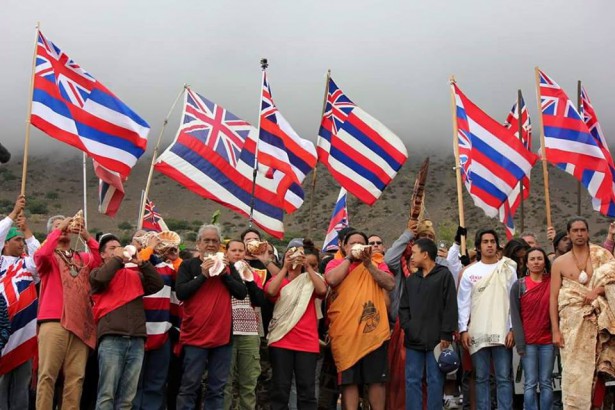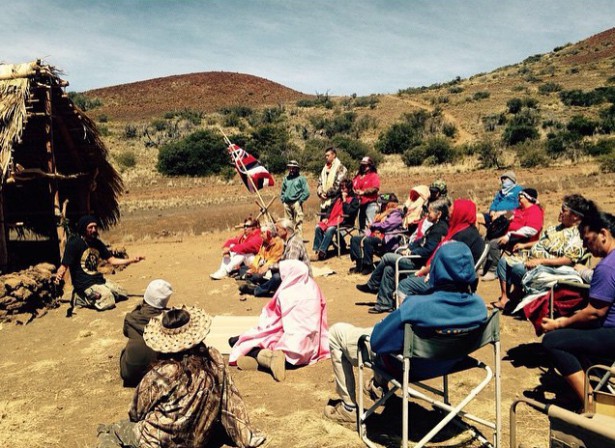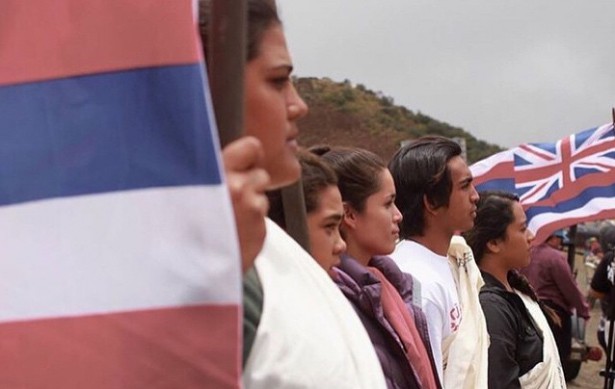Hawaii’s Mauna Kea Protectors Aim to Halt Construction of $1.4 billion, 30-meter telescope on Sacred Mountain
INDIGENOUS RIGHTS, ANGLO AMERICA, ASIA--PACIFIC, 11 May 2015
Imani Altemus-Williams – Waging Nonviolence

Mauna Kea protectors blow the Pū or conch shell to mark the beginning of a ceremony. (Facebook / We Are Mauna Kea)
5 May 2015 – In the early morning of March 23, Native Hawaiian cultural practitioner Lanakila Mangauil heard that construction of the world’s largest optical telescope had begun atop the Hawaiian sacred mountain Mauna Kea. He immediately spread the word to the community, who had been keeping vigilant watch, and ran up the summit to stop the desecration of this wahi pana, a place of cultural significance and practice. Others followed Lanakila’s lead, however, nobody expected that this would spark a global movement to protect one of our planet’s sacred sites.
Canada, China, India, Japan and America are all invested in a $1.4 billion project to build a 30-meter telescope, known as TMT — short for Thirty Meter Telescope — atop Mauna Kea, which means White Mountain in Hawaiian. The shield volcano stands at 13,796 feet tall and is one million years old. When measured from base to peak, it surpasses the height of Mount Everest, making it the world’s tallest mountain. Even though the summit already houses a dozen other telescopes, the University of Hawaii has agreed to lease the land for the construction of this record-breaking build. TMT is anticipated to be finished in 2024.
Resistance against the project has been ongoing for years, but the recent onset of development has ignited a movement that is uniting the people of Hawaii on all islands and abroad. Many say they haven’t seen civil resistance like this since the fight to reclaim Kaho’olawe, where young Hawaiians occupied the island that was being used as a U.S. military training ground and bombing range in 1976.
For over a month, people referring to themselves as the “Mauna Kea protectors” — instead of protesters — have staged an encampment on the mountain to blockade construction. They have engaged in traditional ceremony, poetry, protest song and particularly dance, as people from around the world traveled to the city of Hilo on the island of Hawaii for the Merry Monarch Hula Festival. Hula groups and musicians traveled up to the summit to dance, sing and chant for the gods and goddesses of the mountain. Thirty-one protectors were arrested for preventing work vehicles from getting to their sites. Although they were charged with trespassing and disobedience, they maintain with conviction that they have done everything with aloha, which loosely translates to love, peace and compassion. As a result of their blockade, construction has been held indefinitely.
All people who join the encampment must abide by Kapu Aloha, a system where each protector can only express aloha while on the mountain.
“We are in a place where there is no turning back,” said Hawaiian cultural practitioner and Mauna Kea protector Pua Case. “We will not divide. We will not hurt one another. But we will stand as our Mauna stands, with a pure heart.”
The protectors say they’re not against science or TMT itself, but that they just don’t want it built on Mauna Kea. Hawaiians are known for their scientific knowledge, particularly ancient star navigation. The Polynesian Voyaging Society, for instance, is currently sailing one of Hawaii’s pride and joys — the Hōkūleʻa, a double-hulled canoe — around the globe and is bridging indigenous and modern science. Native Hawaiian groups support many scientific efforts, but they understand that Mauna Kea is not the appropriate place for it.
This movement is gaining national and international support, particularly by indigenous and First Nation peoples. Demonstrations have been held across the globe from Australia to Canada to China to Saudi Arabia and throughout the continental United States. They have extended their support because they are aware that sacred sites are being violated around the world, and they understand the significance of protecting them. Chief Arvol Looking Horse, spiritual leader of the Lakota, Dakota and Nakota nations and the 19th generation keeper of the Sacred White Buffalo Calf Pipe released a statement of solidarity. He likened indigenous sacred sites to a church or temple, and illustrated the importance of protecting Mauna Kea for all people by saying, “We, the spiritual leaders and medicine people, know that the sacred site is part of all of our lives.”
According to 17-year-old protector Kay Ala Kahaulelio, “The sacredness of Mauna Kea is beyond what we can comprehend in the human realm. It is so sacred because it is the portal and the closest temple where we can connect with our akua [god].”
In Hawaiian genealogy, the mountain is revered as the piko, or center of one’s being, for Hawaii Island. It holds burial grounds and is a place where people scatter the ashes of their loved ones. In a press release, the protectors explained that the summit is also the domain of Hawaiian gods and goddesses.
The water in Lake Waiau atop the mountain is used for ceremonies and healing. People fear that contaminants from the construction, such as sewage, mercury, diesel, ethylene and glycol, which are used in quite large amounts, could flood their freshwater supply as the mountain feeds the largest aquifer on the island of Hawaii.
In a message to Gov. David Ige, Mauna Kea protector Kamahana Kealoha said, “Consider the legal ramifications of denying kanaka [human beings], and all Hawaii citizens, the basic humanity and protections securing the absolute safety of Hawaii Island’s main freshwater aquifer, a resource essential to all life.”

A morning gathering at the encampment on April 22 to share life experience and knowledge. (Facebook / Protect Mauna Kea)
Development atop Mauna Kea could result in dismal long-term effects for those living on Hawaii Island. Expansion without concern for its impact on the entire archipelago is in conflict with the indigenous Hawaiian culture. Ancient Hawaiians lived sustainably through the ahupua’a, or land division system — a communal model that equitably managed land, resources and work. Land division ranged from the mountaintops to the sea.
“What often happens in the summits of Mauna Kea will affect everything that happens below, all the way to the coastline, including our oceans,” explained Julie A.K. Leialoha, a biologist and natural area specialist.
All resources were managed as a whole because there was the understanding that what happens high on the mountains will affect the ground and oceans below.
Western scientists consider Mauna Kea an ideal location to see 13 billion light years away, but the Hawaiian community claims that an 18-story telescope on top of their sacred mountain violates both cultural and environmental laws in Hawaii. There are eight criteria that need to be enforced in order to attain a permit in a conservation area. The protectors claim the state Board of Land and Natural Resources did not follow these standards when they granted permission for TMT to be built on Mauna Kea. A lawsuit has been filed in the Intermediate Court of Appeals and the 3rd Circuit Court, arguing that TMT did not meet the regulatory demands. Many believe construction should not move forward until the court of appeals has made its decision.
This movement is about more than fighting against the desecration of this sacred mountain. It has become a platform for native Hawaiians to speak about Hawaiian independence as well. Another considerable argument in the courts is that the nation of Hawaii is still under illegal occupation by the U.S. government, and the Hawaiian Kingdom still exists. On November 28, 1843, the Hawaiian Kingdom was recognized as an independent sovereign nation by joint proclamation from Great Britain and France. In 1893, a U.S. marine’s armed coup d’etat overthrew the Hawaiian Kingdom government. Despite local resistance, the islands were seized five years later for strategic military use during the Spanish-American War.
As the protectors stated in a press release, “Protectors of the mountain call upon all countries involved to honor the continued independence of Hawaii that America has refused to acknowledge for the last 122 years while illegally occupying Hawaii in violation of the laws of occupation.” If the state of Hawaii is illegal, then all agreements between the state and TMT investors are illegal as well.
Since the overthrow of the Hawaiian Kingdom, Native Hawaiians have endured the desecration of their land, culture, spirituality and way of life. But through their actions to protect Mauna Kea, they are saying, “enough is enough.”
________________________________
Imani Altemus-Williams is a recent graduate of the New School. She has been active in Occupy Wall Street and works with undocumented and indigenous activism, anti-mass-incarceration organizing and popular radical education projects in New York City.
Go to Original – wagingnonviolence.org
DISCLAIMER: The statements, views and opinions expressed in pieces republished here are solely those of the authors and do not necessarily represent those of TMS. In accordance with title 17 U.S.C. section 107, this material is distributed without profit to those who have expressed a prior interest in receiving the included information for research and educational purposes. TMS has no affiliation whatsoever with the originator of this article nor is TMS endorsed or sponsored by the originator. “GO TO ORIGINAL” links are provided as a convenience to our readers and allow for verification of authenticity. However, as originating pages are often updated by their originating host sites, the versions posted may not match the versions our readers view when clicking the “GO TO ORIGINAL” links. This site contains copyrighted material the use of which has not always been specifically authorized by the copyright owner. We are making such material available in our efforts to advance understanding of environmental, political, human rights, economic, democracy, scientific, and social justice issues, etc. We believe this constitutes a ‘fair use’ of any such copyrighted material as provided for in section 107 of the US Copyright Law. In accordance with Title 17 U.S.C. Section 107, the material on this site is distributed without profit to those who have expressed a prior interest in receiving the included information for research and educational purposes. For more information go to: http://www.law.cornell.edu/uscode/17/107.shtml. If you wish to use copyrighted material from this site for purposes of your own that go beyond ‘fair use’, you must obtain permission from the copyright owner.
Read more
Click here to go to the current weekly digest or pick another article:
INDIGENOUS RIGHTS:
- We Must Purge Genocide from the Marrow of Our Bones
- The Day of the World’s Indigenous Peoples
- ‘A World without Borders’: Revolutionary Love and Solidarity for Palestine
ANGLO AMERICA:
- Washington Green-Lights $30M for Gaza Aid Scheme Tied to Mass Killings of Palestinians
- War with Iran: We Are Opening Pandora's Box
- Trump’s Useful Idiots
ASIA--PACIFIC:
